This article needs additional citations for verification .(June 2022) |
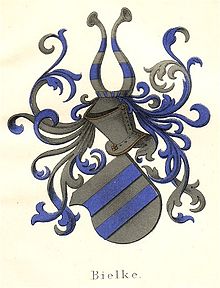

The Bjelke family, also spelled Bielke, was a Danish and Norwegian noble family, known since the mid-15th century and extinct in 1868.
This article needs additional citations for verification .(June 2022) |


The Bjelke family, also spelled Bielke, was a Danish and Norwegian noble family, known since the mid-15th century and extinct in 1868.
The family's progenitor was Josef Andersen of Gyllarp in Scania, living in the middle of the 15th century. His son Tilluf Josefsen to Gyllarp was the father of Jens Tillufsen Bjelke, who by his marriage to Lucie Nielsdatter Gyldenløve came to possess Austrått Fortress and Estate i Ørland, Norway. In the 17th century, this family was among the mightiest in the kingdom. The last man of the family was Carl Frederik Bjelke (1837–1868).
The family's arms are a silver shield depicting two blue beams (Norwegian : bjelke).
The coat of arms appears, among other places, in family members' wax seals, in heraldic artworks at Austrått Fortress, and in a portrait of Ove Bjelke.
The family has no confirmed connection to the Swedish family Bielke.
The other Bjelke family in Norway, living today, descends from the Swedish Bielke family known as Lilliebjelke (‘Lily Beam’).

The Paus family is a prominent Norwegian family with a long history of involvement in the clergy, nobility, industry, and the arts. The family first emerged as members of the elite of 16th-century Oslo and, for centuries, belonged to Norway's "aristocracy of officials," especially in the clergy and legal professions in Upper Telemark. Later generations became involved in shipping, steel, and banking. The family is particularly known for its close association with Henrik Ibsen, and for modern members like the singer Ole Paus.
The aristocracy of Norway is the modern and medieval aristocracy in Norway. Additionally, there have been economical, political, and military elites that—relating to the main lines of Norway's history—are generally accepted as nominal predecessors of the aforementioned. Since the 16th century, modern aristocracy is known as nobility.

Ingerd Ottesdotter (Rømer) was her era's wealthiest landowner in Norway. She was the ultimate heiress of the noble Rømer family and a political intriguer. Lady Ingerd is noted for having orchestrated her powerful sons-in-law to support her goals. Her fame was the inspiration for Henrik Ibsen's play Lady Inger of Ostrat.

Austrått or Austrått Manor is a manor in Ørland municipality in Trøndelag county, Norway. Since the 10th century, Austrått has been the residence for many noblemen, noblewomen, and officials who played a significant role in Norwegian history. In historical records, Austrått can also be found written as Østråt, Østeraat, Østeraad, Austaat, and Austråt.

Jens Tillufssøn Bjelke was a Danish-Norwegian nobleman and a feudal lord of Jemtland, Norway, was originally from Danish Skåne. Jens Tillufssøn Bjelke was one of several notable Danes who acquired land, resided permanently in Norway, became thoroughly Norwegian and founded new Norwegian noble families, which replaced the old nobility of the first rank. He was the grandfather of Chancellor Jens Ågessøn Bjelke and great-grandfather of Governor Jorgen Bjelke.

Henrich Krummedige, was born circa 1464 in Norway and died in 1530. He was a Danish-Norwegian nobleman and a member of both the Norwegian and Danish National Councils (Rigsråd) and played an extensive role in the politics of the era. He served as commanding officer of the Bohus Fortress in Norway from 1489 to 1503.
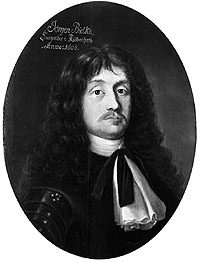
Jørgen Bjelke was a Norwegian officer and nobleman. He was born at Elingaard Manor on Onsøy near Fredrikstad, in Østfold County, Norway and died in Kalundborg, Denmark.

The Gyldenstjerne family, also spelled Gyldenstierne, is a Danish, Norwegian, and Swedish noble family divided into various branches and ranks. It is one of the oldest noble families in Scandinavia. The family surname appears, in the form of Guildenstern, in William Shakespeare's tragedy The Tragedy of Hamlet, Prince of Denmark. The surname should not be confused with Gyldensteen, the name of another short-lived Danish noble family, first recorded in 1717 and which became extinct in 1749.
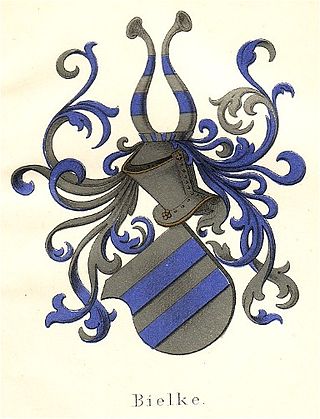
Jens Ågessøn Bjelke was a Norwegian nobleman who was Chancellor of Norway from 1614 to 1659, and was succeeded by his son Ove Bjelke. He was the son of Åge Bjelke and Margrethe Thott. At the time of his death, he was Norway's largest land owner. After his tenure as Chancellor, the office largely lost its influence and was abolished in 1679.

The Chancellor of Norway was the most important aide of the King of Norway during the Middle Ages, and during the Union with Denmark. He issued laws and regulations, and was responsible for day-to-day administration of the kingdom. From 1270, the Chancellor resided in Bergen. Haakon V of Norway moved the Chancellor's residence to Oslo; on 31 August 1314 the provost of St Mary's Church became Chancellor on a permanent basis. He was given the Great Seal of the Realm "for eternity." The Chancellors were originally chosen from the clergy but after 1542 the position was given to people from the nobility. The position lost its importance after Jens Bjelke's tenure, and was abolished in 1679.
Events in the year 1660 in Norway.
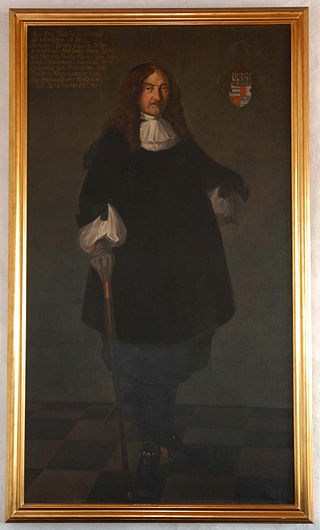
Ove Bjelke was a Norwegian nobleman, feudal lord and statesman. He served as Chancellor of Norway (1660–1674).

Henrik Bjelke was a Norwegian-Danish military officer who served as Admiral of the Realm of Denmark-Norway from 1662 to 1679. He was in command of the Royal Dano-Norwegian Navy from 1657 to 1679. He owned the estates Næsbyholm, Bavelse, and Tersløsegaard south of Copenhagen.
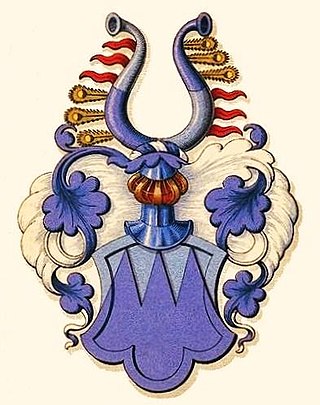
Johan Frederik von Marschalck was a German-born, Norwegian government official and landowner. He served as the last Chancellor of Norway, ending a tradition that had lasted for over 400 years.
Mogens Svale (c.1530–1581) was a Danish-born military commander and landowner in Norway. Svale is noted for his merits during the Northern Seven Years' War (1563-1570).
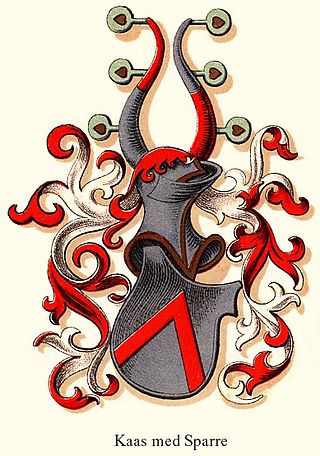
Kaas is the name of two related Danish noble families from Jutland, which were and are, respectively, two of the preeminent families of the Danish Uradel or ancient high nobility, which were represented in the Council of the Realm. They are known as the elder Kaas family and the younger Kaas family or named for their respective coats of arms. Both families appeared in the Middle Ages, and they have been noble since time immemorial. Like all old noble families in Scandinavia, the families are untitled, although individual members in the past held the rank of knight, traditionally the highest rank of Scandinavian nobility and reserved for important statesmen, but always of a non-hereditary nature.

Edelgave is a manor house situated just southwest of Smørumnedre, Egedal Municipality, 20 km northwest of central Copenhagen, Denmark. The current main building was designed by Andreas Kirkerup and is listed.
Sir Peder Povelsson Paus, also rendered as Peter Paus and known locally as Sir Per, was a Norwegian high-ranking cleric who served as the provost of Upper Telemark from 1633 until his death. As provost he was not only the religious leader of the vast region of Upper Telemark, but also one of the foremost government officials in Telemark; during his lifetime the state church was also an important part of the state administration. He is known through a loving poem in Latin written by his son Paul Peterson Paus in his memory in 1653, In memoriam Domini Petri Pavli. His descendants include the playwright Henrik Ibsen and the singer Ole Paus.

The Gyldenhorn family was an aristocratic family in The Kingdom of Denmark-Norway originating from Østfold and founded in the 14th century.
Sir Hans Povelsson Paus the Elder was a Norwegian priest.